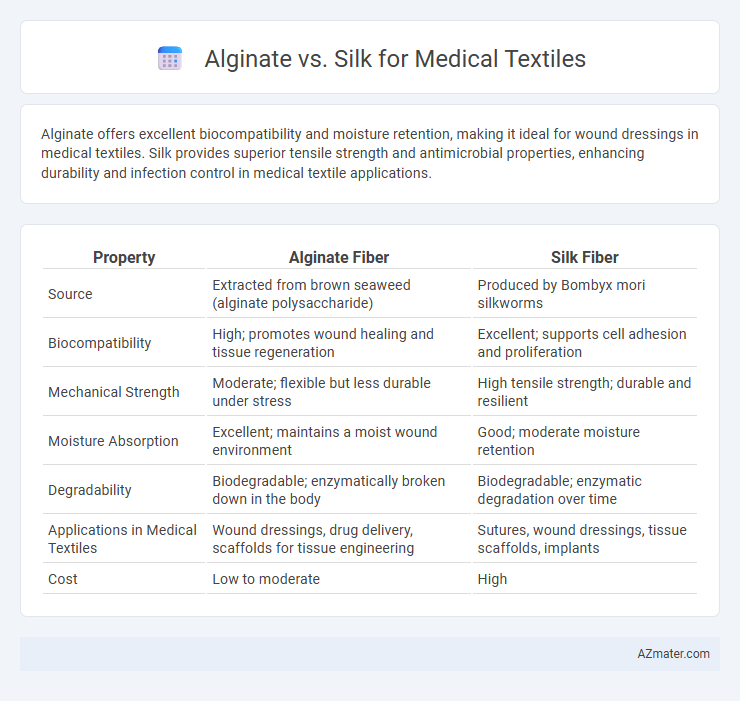Alginate offers excellent biocompatibility and moisture retention, making it ideal for wound dressings in medical textiles. Silk provides superior tensile strength and antimicrobial properties, enhancing durability and infection control in medical textile applications.
Table of Comparison
| Property | Alginate Fiber | Silk Fiber |
|---|---|---|
| Source | Extracted from brown seaweed (alginate polysaccharide) | Produced by Bombyx mori silkworms |
| Biocompatibility | High; promotes wound healing and tissue regeneration | Excellent; supports cell adhesion and proliferation |
| Mechanical Strength | Moderate; flexible but less durable under stress | High tensile strength; durable and resilient |
| Moisture Absorption | Excellent; maintains a moist wound environment | Good; moderate moisture retention |
| Degradability | Biodegradable; enzymatically broken down in the body | Biodegradable; enzymatic degradation over time |
| Applications in Medical Textiles | Wound dressings, drug delivery, scaffolds for tissue engineering | Sutures, wound dressings, tissue scaffolds, implants |
| Cost | Low to moderate | High |
Introduction to Medical Textiles
Medical textiles integrate advanced biomaterials like alginate and silk to enhance wound healing and tissue regeneration. Alginate, derived from seaweed, offers excellent biocompatibility and gel-forming properties crucial for moisture retention and infection control in wound dressings. Silk provides outstanding mechanical strength and biodegradability, making it ideal for sutures, scaffolds, and implants in medical applications.
Overview of Alginate Fibers
Alginate fibers, derived from brown seaweed, are highly valued in medical textiles for their excellent biocompatibility, biodegradability, and ability to maintain a moist wound environment, promoting faster healing. These fibers exhibit superior absorbency and hemostatic properties, making them ideal for wound dressings and surgical pads. Alginate's natural polymer structure also provides antimicrobial benefits and supports cell regeneration, outperforming many traditional materials like silk in specific medical applications.
Properties of Silk in Medical Applications
Silk exhibits exceptional biocompatibility, tensile strength, and biodegradability, making it an ideal material in medical textiles for wound dressings and tissue engineering. Its natural protein structure supports cell adhesion and proliferation, which promotes faster healing and reduces infection risk. The moisture-retentive and breathable properties of silk further enhance patient comfort and accelerate recovery in clinical applications.
Biocompatibility: Alginate vs Silk
Alginate exhibits excellent biocompatibility due to its natural polysaccharide structure, promoting cell adhesion and minimal immune response, making it ideal for wound dressings and tissue engineering. Silk, derived from fibroin protein, also demonstrates superior biocompatibility with outstanding mechanical strength and gradual biodegradability, supporting cell proliferation and integration in medical implants. Comparative studies indicate that while alginate offers high hydrophilicity and swelling capacity for moist environments, silk provides enhanced durability and controlled degradation, crucial for long-term biomedical applications.
Absorption and Moisture Management
Alginate fibers exhibit superior absorption capacity due to their natural hydrophilicity and ability to retain up to 20 times their weight in water, making them ideal for wound dressings requiring rapid exudate management. Silk, while less absorbent than alginate, excels in moisture management through its breathable structure and moisture-wicking properties that help maintain a dry and comfortable skin environment. Combining alginate's high absorption with silk's effective moisture regulation can optimize medical textiles for enhanced wound care and patient comfort.
Mechanical Strength and Durability
Alginate fibers exhibit moderate tensile strength but tend to degrade rapidly in moist environments, limiting their durability in medical textile applications. Silk fibers demonstrate superior mechanical strength and maintain durability under physiological conditions, making them more suitable for long-term medical textiles. The high biocompatibility and robust structural integrity of silk enhance its functionality in wound dressings and implantable devices compared to alginate-based materials.
Wound Healing Efficacy
Alginate fibers derived from seaweed exhibit high absorbency, promoting a moist wound environment that accelerates healing and reduces infection risk. Silk fibers offer biocompatibility and tensile strength, supporting cellular growth and tissue regeneration in wound dressings. Comparative studies highlight alginate's superior exudate management, while silk enhances structural integrity and cell adhesion during the healing process.
Sterilization and Safety Concerns
Alginate offers excellent biocompatibility and can withstand common sterilization methods such as steam autoclaving and ethylene oxide without significant degradation, ensuring safety in medical textile applications. Silk, while possessing superior mechanical strength and biodegradability, is sensitive to high-temperature sterilization processes, often requiring low-temperature methods like gamma irradiation or chemical sterilants to maintain fiber integrity. Both materials present distinct sterilization challenges; alginate's hydrophilic nature demands careful moisture control, whereas silk's protein structure necessitates gentle handling to mitigate immunogenic responses and preserve safety standards.
Cost and Scalability for Medical Use
Alginate fibers offer cost-effective production with abundant natural sources from seaweed, making them economically favorable for large-scale medical textile manufacturing. Silk, derived from silkworms, involves higher production costs and scalability challenges due to labor-intensive harvesting and processing methods. For scalable medical applications, alginate provides a more budget-friendly and easily expandable solution compared to the premium-price, less scalable silk textiles.
Future Prospects: Alginate and Silk in Medical Textiles
Alginate and silk exhibit promising future prospects in medical textiles due to their biocompatibility and biodegradability. Alginate's strong wound healing capabilities and gel-forming properties make it ideal for advanced wound dressings and drug delivery systems. Silk's mechanical strength and ability to support cell growth position it as a superior material for tissue engineering and regenerative medicine applications.

Infographic: Alginate vs Silk for Medical textile
 azmater.com
azmater.com